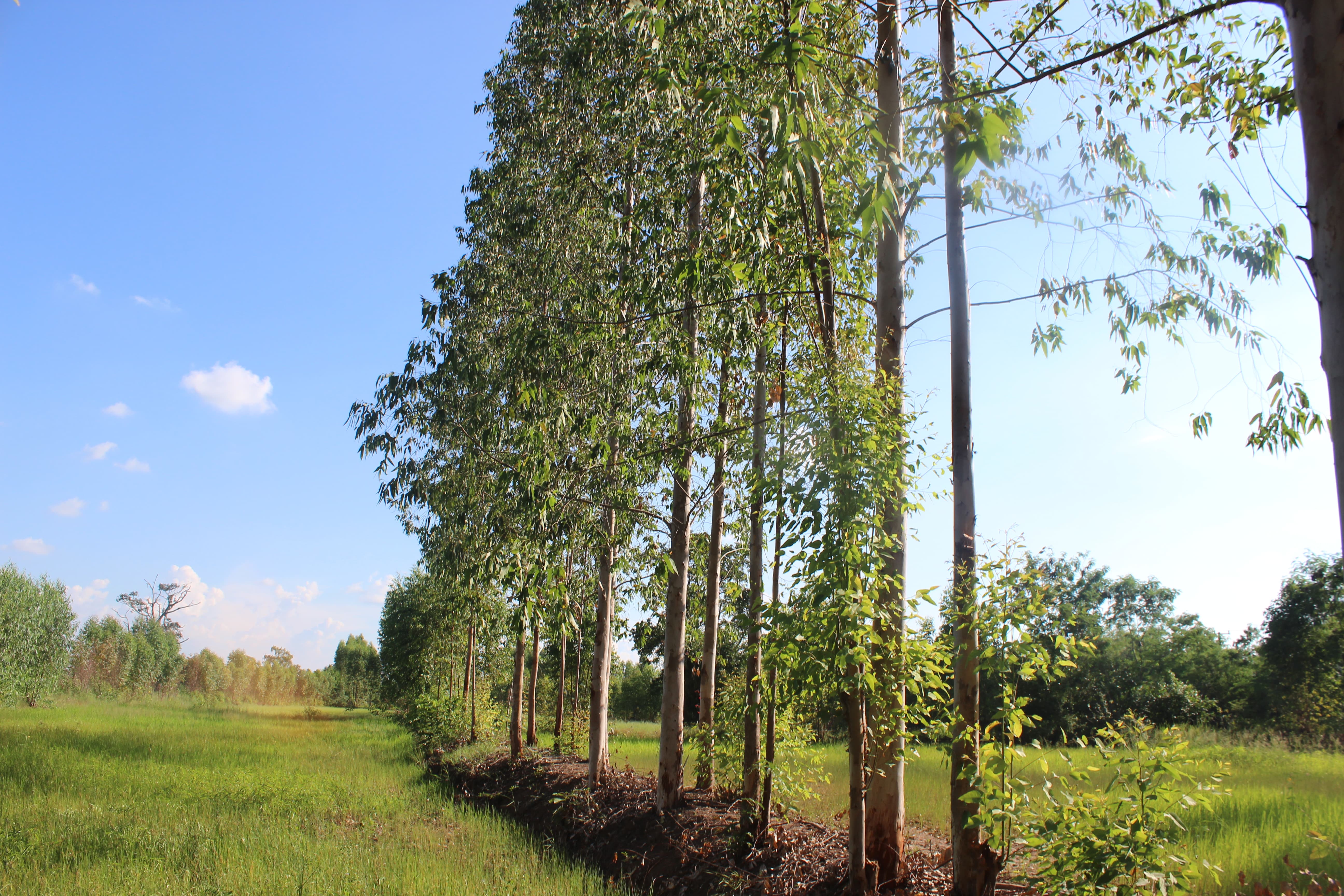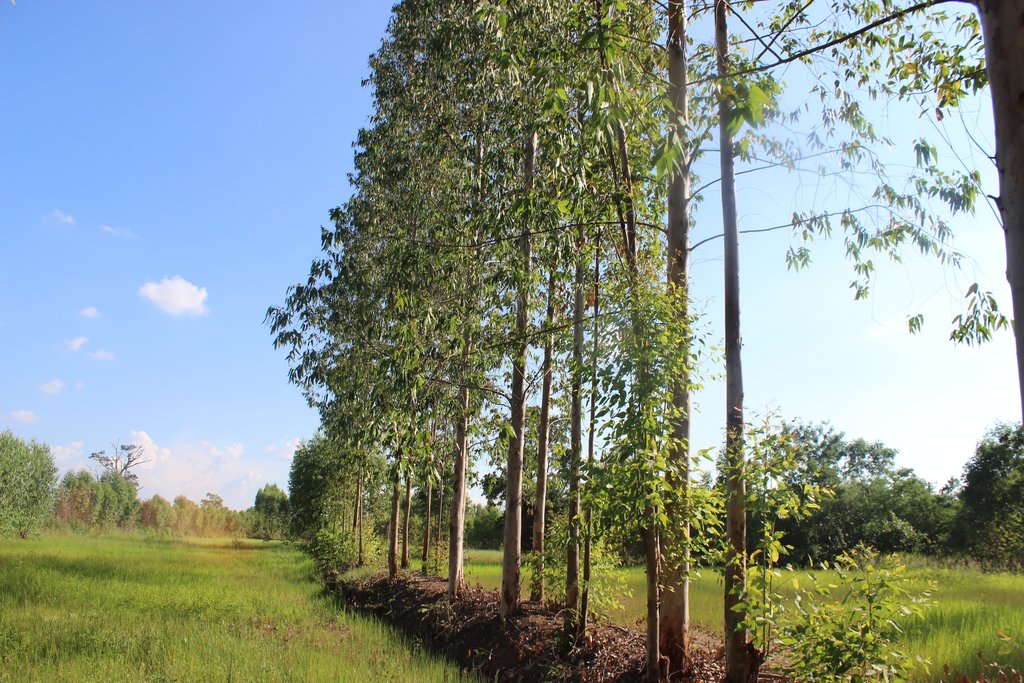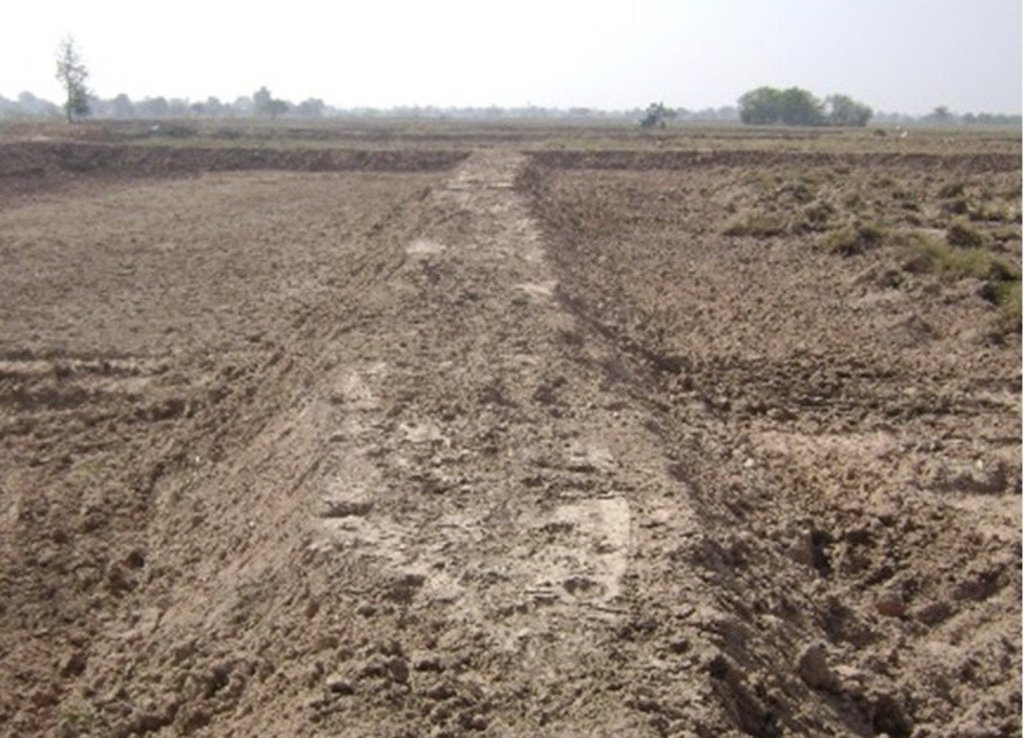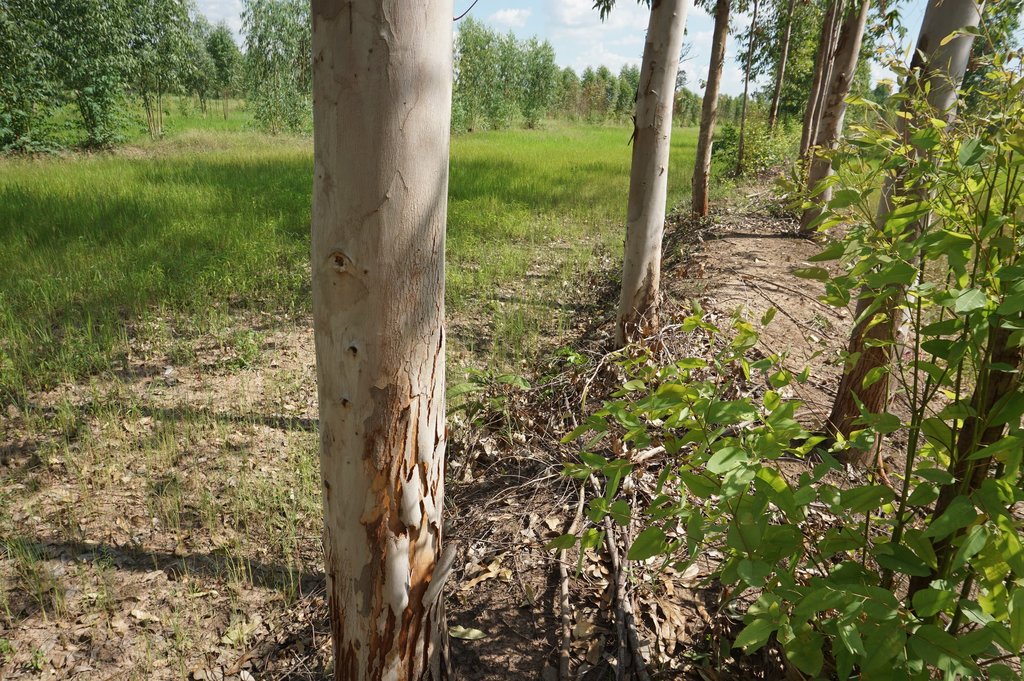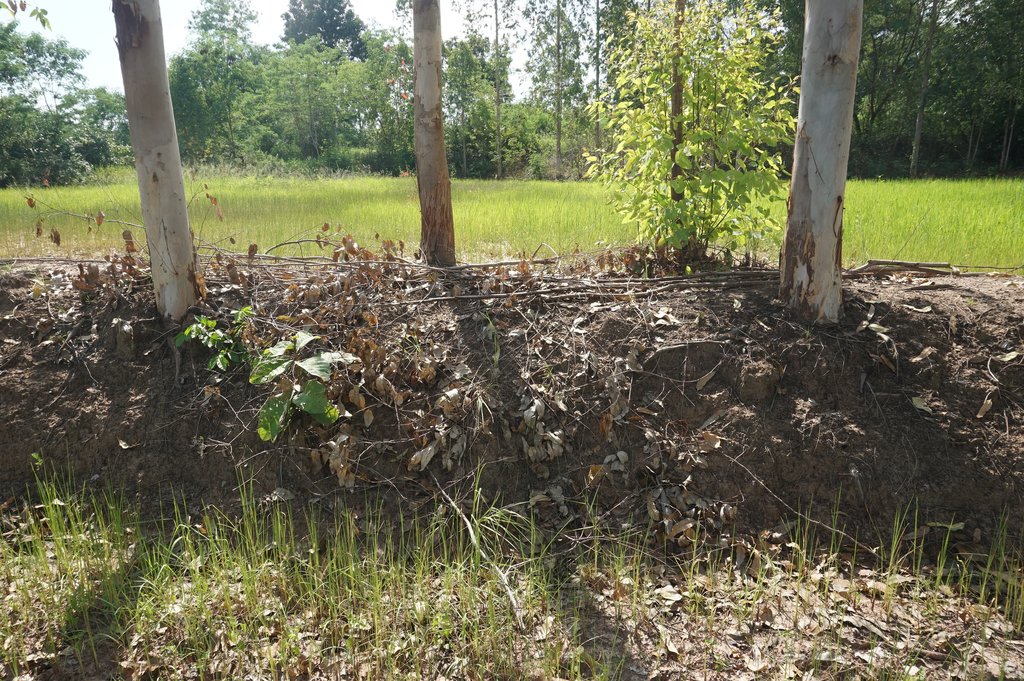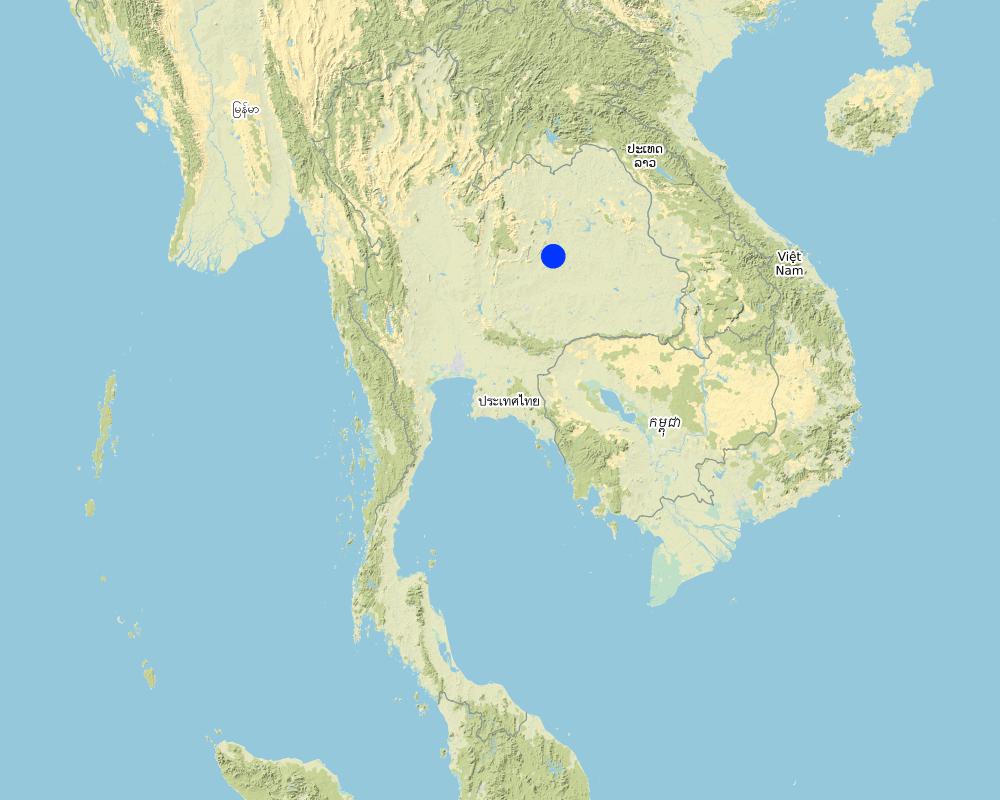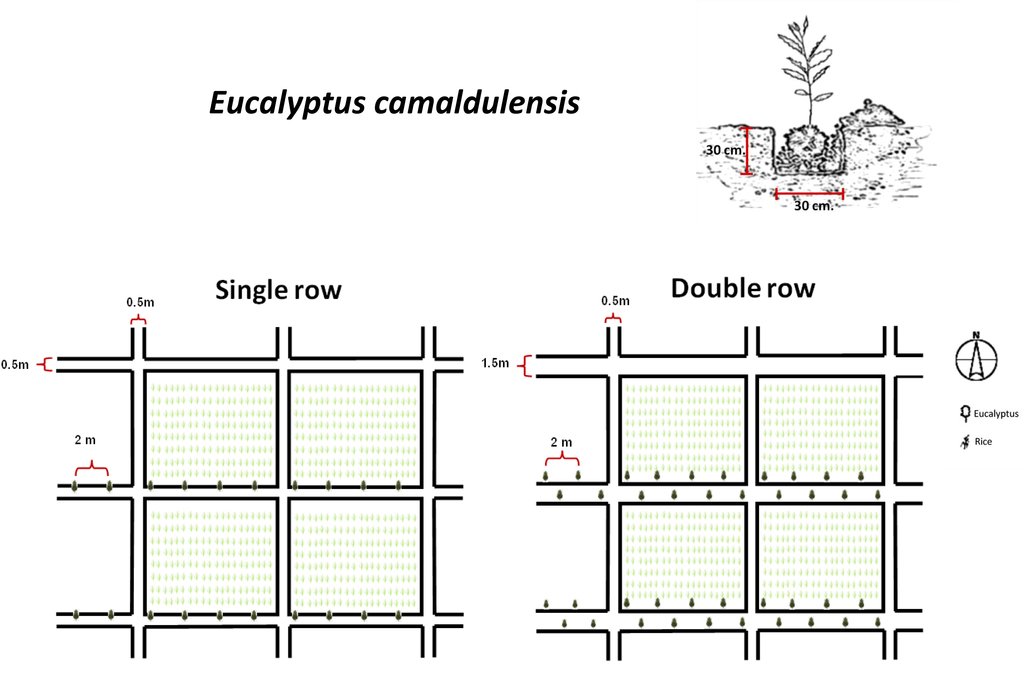Planting Eucalyptus on rice bunds to lower saline groundwater [Tailândia]
- Criação:
- Atualização:
- Compilador/a: Areerat Wangkaew
- Editor: –
- Revisores: Rima Mekdaschi Studer, Samran Sombatpanit, Pitayakon Limtong, William Critchley
Planting perennial salt-tolerant trees in salt-affected areas of the Northeast of Thailand.
technologies_4099 - Tailândia
Veja as seções
Expandir tudo Recolher tudo1. Informação geral
1.2 Detalhes do contato das pessoas capacitadas e instituições envolvidas na avaliação e documentação da tecnologia
Pessoa(s) capacitada(s)
usuário de terra:
Chuenchai Sayan
+66-99-0254108
Ban Muang Pia, Muang Pia Sub-district, Ban Phai District, Khon Kaen 40110
Tailândia
Especialista em GST:
Sritumboon Supranee
ssritumboon@yahoo.com
Land Development Department
2003, 61 Phaholyothin Road, Ladyao, Chatuchak, Bangkok 10900
Tailândia
Especialista em GST:
Pothinam Pornpana
laosuwan18@hotmail.com
Land Development Department
2003, 61 Phaholyothin Road, Ladyao, Chatuchak, Bangkok 10900
Tailândia
Especialista em GST:
Rophandung Weera
weerop@hotmail.com
Land Development Department
2003, 61 Phaholyothin Road, Ladyao, Chatuchak, Bangkok 10900
Tailândia
Especialista em GST:
Srihaban Pranee
pranee.782@gmail.com
Land Development Department
2003, 61 Phaholyothin Road, Ladyao, Chatuchak, Bangkok 10900
Tailândia
Especialista em GST:
Jakkarach Usa
usa.kl@hotmail.com
Land Development Department
2003, 61 Phaholyothin Road, Ladyao, Chatuchak, Bangkok 10900
Tailândia
Especialista em GST:
Janplang Chettaruj
joeshua9@hotmail.com
Land Development Department
2003, 61 Phaholyothin Road, Ladyao, Chatuchak, Bangkok 10900
Tailândia
National consultant:
Arunin Somsri
ssarunin@gmail.com
Land Development Department
2003, 61 Phaholyothin Road, Ladyao, Chatuchak, Bangkok 10900
Tailândia
Nome do projeto que facilitou a documentação/avaliação da Tecnologia (se relevante)
Decision Support for Mainstreaming and Scaling out Sustainable Land Management (GEF-FAO / DS-SLM)Nome da(s) instituição(ões) que facilitou(ram) a documentação/ avaliação da Tecnologia (se relevante)
Land Development Department LDD (Land Development Department LDD) - Tailândia1.3 Condições em relação ao uso da informação documentada através de WOCAT
Quando os dados foram compilados (no campo)?
01/10/2018
O/a compilador/a e a(s) pessoa(s) capacitada(s) aceitam as condições relativas ao uso de dados documentados através da WOCAT:
Sim
1.4 Declaração de sustentabilidade da tecnologia descrita
A tecnologia descrita aqui é problemática em relação a degradação da terra de forma que não pode ser declarada uma tecnologia de gestão sustentável de terra?
Não
Comentários:
The technology is environmentally suited and very well accepted by the land users.
1.5 Referência ao(s) questionário(s) sobre as abordagens da GST
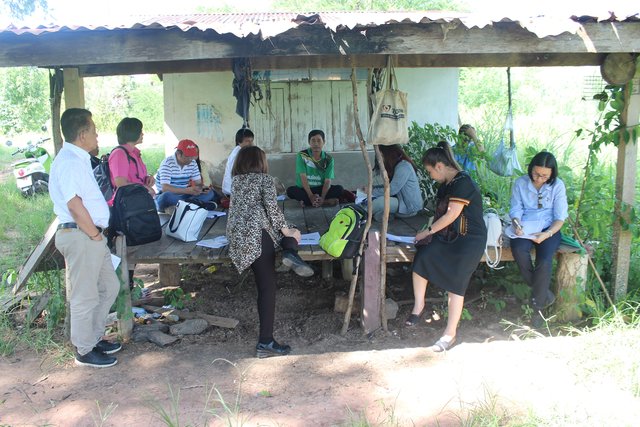
Advisory system for planting Eucalyptus camaldulensis on rice … [Tailândia]
The Thai government promotes planting of Eucalyptus camaldulensis on rice bunds to lower the saline groundwater level and prevent the spread of salt in soils - through cooperation of farmers, land owners, Siam Forestry Co., Ltd., Subdistrict Administration Organization, Land Development Department, and with specialists/ technical advisors.
- Compilador/a: Areerat Wangkaew
2. Descrição da tecnologia de GST
2.1 Descrição curta da tecnologia
Definição da tecnologia:
Eucalyptus camaldulensis variety H4 is salt tolerant and has the ability to lower shallow saline groundwater levels; as a result salinity is controlled. Planting eucalyptus on one or two sides of the rice bund in an east-west direction (in single or double rows) at a spacing of 2 m between trees is the most effective technique and well accepted by farmers.
2.2 Descrição detalhada da tecnologia
Descrição:
Eucalyptus camaldulensis cultivation on rice bunds to lower shallow saline groundwater levels in low-lying areas is a technology used on salt-affected land. The LDD Perennial Tree Planting project to promote the technology of planting Eucalyptus camaldulensis on rice bunds has been implemented since 1996. The land user interviewed cultivates a moderately salt-affected rice field at Ban Muang Pia District, Khon Kaen Province. The land is used for rice production both glutinous (variety RD 6) and non-glutinous fragrant rice (Hom Mali 105). The average yield of rice is 200-250 kg/rai (1 ha = 6.25 rai). The farmers have planted eucalyptus on bunds in the rice cultivated areas on about 10,000 rai in more than 10 years with the objectives of remedying and preventing salination by lowering shallow saline groundwater levels, through "bio-drainage" as well as increasing income and better utilization of lands on rice bunds for growing trees.
The technology of eucalyptus cultivation on rice bunds has been implemented in farmers' fields in the low-lying salt-affected rice area common in the Northeast of Thailand. It is widely accepted by farmers through the joint partnership between the Land Development Department (LDD), Siam Forestry Co., Ltd. and the local district administration. Eucalyptus seedlings are provided by LDD and are planted in a single or double rows - double rows with trees planted on two sides of the rice bunds in a zigzag manner following an east-west direction to prohibit a shadow effect. The spacing between the trees in a row is 2 m: the rice bund was adapted to be 1.5 m wide and 0.5 m high. This provides more space and convenient access to the rice field. The project provides labour costs for farmers to prepare the land before planting. Many farmers outside the project transplanted their own eucalyptus seedlings on the bunds of 0.5 m or more in width. Farmers buy the seedlings at 1 THB each and plant in pits of 0.3 x 0.3 x 0.3 m with 0.5 kg compost and 0.5 kg rice husks from farm by-products. This technology is well accepted by farmers because of the effective control of salinity in the rice fields as well as the higher income obtained from selling eucalyptus wood. Farmers observed the dead patchy spots of rice plants with salt crusts before planting eucalyptus: after 2 cutting cycles no salt patches were observed anymore, and rice yields increased noticeably. There was also extra income from selling poles of eucalyptus every 4 years. The average yield of eucalyptus trees of 2.5-3.0 inches in diameter was 16 tons per rai for the first cutting.
Based on 7 years (2 crops of eucalyptus coppicing), the average additional income was 1,087 THB/rai/yr (according to the farmers' and Siam Forest's information). The main investment was in the first year of planting; later on, the maintenance cost was on labour for weeding, pruning and thinning to 3 stems after coppice/cutting, including adding 15-15-15 fertilizer for each tree. The average income is increased through better rice yields. The benefits of the technology according to interviews are creating a cooler microclimate from eucalyptus trees and changes in biodiversity through better soil quality resulting in more species of flora and fauna such as grasses, wildflowers, dragonflies, earthworms in the rice field and on the bund. Some farmers wanted more trees by planting at closer spacing of 1 m, but this resulted in too great a density of trees thus consuming more surface water and competing with rice for water consumptive use.
2.3 Fotos da tecnologia
2.4 Vídeos da tecnologia
Comentários, breve descrição:
The video shows the area of eucalyptus growing on the rice bund.
Data:
01/10/2018
Localização:
Ban Muang Pia, Khon Kaen
Nome do cinegrafista:
Supranee Sritumboon
Comentários, breve descrição:
Farmer interview and SLM discussion.
Data:
01/10/2018
Localização:
Ban Muang Pia, Khon Kaen
Nome do cinegrafista:
Supranee Sritumboon
2.5 País/região/locais onde a tecnologia foi aplicada e que estão cobertos nesta avaliação
País:
Tailândia
Região/Estado/Província:
Khon Kaen
Especificação adicional de localização:
Ban Phai
Comentários:
The SLM Technology site for planting eucalyptus in a rice production area.
Map
×2.6 Data da implementação
Indique o ano de implementação:
1996
2.7 Introdução da tecnologia
Especifique como a tecnologia foi introduzida:
- através de projetos/intervenções externas
- by other land users
Comentários (tipos de projeto, etc.):
The project initiated by the government (Land Development Department) collaborated with private enterprises (Siam Forestry Co., Ltd.), local administration, communities and land users.
3. Classificação da tecnologia de GST
3.1 Principal/principais finalidade(s) da tecnologia
- Melhora a produção
- Reduz, previne, recupera a degradação do solo
- Preservar/melhorar a biodiversidade
- Criar impacto econômico benéfico
3.2 Tipo(s) atualizado(s) de uso da terra onde a tecnologia foi aplicada

Terra de cultivo
- Cultura anual
- Cultura perene (não lenhosa)
Principais plantações (colheitas para venda e consumo próprio):
Rice
Comentários:
Planting eucalyptus for additional income and more intensive utilization of land on the rice bunds.
Caso o uso da terra tenha mudado devido a implementação da tecnologia, indique seu uso anterior à implementação da tecnologia:
Before planting eucalyptus, rice was the only crop. Due to the shallow saline groundwater of the area, rice had shown symptoms of being salt-affected; however after planting eucalyptus trees, these symptoms disappeared.
3.3 Mais informações sobre o uso da terra
Abastecimento de água para a terra na qual a tecnologia é aplicada:
- Precipitação natural
Comentários:
Average annual rainfall is 1,200-1,300 mm.
Número de estações de cultivo por ano:
- 1
Especifique:
Land use is for rice production; the technology is planting Eucalyptus camaldulensis on rice bunds.
Densidade animal (se relevante):
Only few cattle, swine, and boar are in the land user's farm.
3.4 Grupo de GST ao qual pertence a tecnologia
- Agrofloresta
- Gestão do lençol freático
- desalination
3.5 Difusão da tecnologia
Especifique a difusão da tecnologia:
- Uniformemente difundida numa área
Caso a tecnologia seja uniformemente difundida numa área, indique a área coberta aproximada:
- 1-10 km2
Comentários:
The technology has spread over the area of 10,000 rai (1 ha = 6.25 rai) owned by farmers/land users both under and outside the supported project of planting eucalyptus on rice bunds.
3.6 Medidas de GST contendo a tecnologia

Medidas agronômicas
- A2: Matéria orgânica/fertilidade do solo
- A5: Gestão de sementes, variedades melhoradas

Outras medidas
Comentários:
Eucalyptus camaldulensis H4 is the salt-tolerant variety used for lowering shallow saline groundwater.
3.7 Principais tipos de degradação da terra abordados pela tecnologia

Deteriorização química do solo
- Cn: declínio de fertilidade e teor reduzido de matéria orgânica (não causado pela erosão)
- Cs: salinização/alcalinização

Deteriorização física do solo
- Pc: Compactação
- Pk: quebra e ressecamento

Degradação biológica
- Bc: redução da cobertura vegetal
- Bq: quantidade/ declínio da biomassa
- Bs: Qualidade e composição de espécies/declínio de diversidade
- Bl: perda da vida do solo

Degradação da água
- Hg: mudança no lençol freático/aquífero
- Hq: declínio da qualidade do lençol freático
3.8 Redução, prevenção ou recuperação da degradação do solo
Especifique o objetivo da tecnologia em relação a degradação da terra:
- Reduzir a degradação do solo
- Recuperar/reabilitar solo severamente degradado
Comentários:
Decreased saline groundwater levels to control salinity distribution in rice cultivated areas.
4. Especificações técnicas, implementação de atividades, entradas e custos
4.1 Desenho técnico da tecnologia
4.2 Especificações técnicas/ explicações do desenho técnico
1. Seedling of Eucalyptus camaldulensis H4, a salt-tolerant variety, were planted. The age of seedlings was 3-month old. The rice bund was regulated to 0.5 m wide for planting eucalyptus in single row or 1.5 m wide for planting in double rows (in a zigzag manner), 0.5 m high with a spacing of 2 m between the trees along an east-west direction. The number of trees was 80/rai or 500/ha for double rows planting.
2. Planting technique: 0.5 kg of compost mixed with 0.5 kg of rice husks was applied at the bottom of a pit of 0.3 x 0.3 x 0.3 m before seedlings were planted.
4.3 Informação geral em relação ao cálculo de entradas e custos
Especifique como custos e entradas foram calculados:
- por área de tecnologia
Indique o tamanho e a unidade de área:
own by one selected land user
Caso esteja usando uma unidade de área local, indique o fator de conversão para um hectare:
1 hectare = 6.25 rai
Outro/moeda nacional (especifique):
THB
Indique a taxa cambial do dólar norte americano para a moeda local (se relevante): 1 USD =:
32,0
Indique a média salarial da mão-de-obra contratada por dia:
300 THB
4.4 Atividades de implantação
| Atividade | Tipo de medida | Periodicidade | |
|---|---|---|---|
| 1. | Site selection of salt-affected area | Estrutural | May-July |
| 2. | Land preparation; bunds construction and seedling preparation | Estrutural | May-July |
| 3. | Public hearing, joint meeting between farmers and researchers | Outras medidas | May-July |
| 4. | Demonstration plot | Agronômico | May-July |
| 5. | Model establishment (Eucalyptus planting method) | Agronômico | May-July |
| 6. | Joint monitoring, evaluation and follow up for planting | Outras medidas | After planting |
Comentários:
No irrigation water therefore the planting time depends on the period of early rainy season which will be from May to July.
4.5 Custos e entradas necessárias para a implantação
| Especifique a entrada | Unidade | Quantidade | Custos por unidade | Custos totais por entrada | % dos custos arcados pelos usuários da terra | |
|---|---|---|---|---|---|---|
| Mão-de-obra | Labour cost for planting eucalyptus (labour wage per day = 300 THB, 1 rai required a labour cost of 600 THB) | Rai | 1,0 | 600,0 | 600,0 | |
| Material vegetal | Eucalyptus seedling cost (80 trees/rai), 1 THB for each seedling | Seedling | 80,0 | 1,0 | 80,0 | |
| Fertilizantes e biocidas | Compost cost 3.5 THB/kg, 0.5 kg/pit | kg | 40,0 | 3,5 | 140,0 | |
| Fertilizantes e biocidas | Rice husk cost 4 THB/kg, 0.5 kg/pit | kg | 40,0 | 4,0 | 160,0 | |
| Custos totais para a implantação da tecnologia | 980,0 | |||||
Se o usuário da terra arca com menos que 100% dos custos, indique quem cobre os custos remanescentes:
Land Development Department
Comentários:
Labour cost for land preparation and planting borne by LDD and seedlings borne by Siam Forestry Co., Ltd.; compost and rice husk were from farm by-products.
4.6 Atividades recorrentes/manutenção
| Atividade | Tipo de medida | Periodicidade/frequência | |
|---|---|---|---|
| 1. | Thinning and pruning after first year of planting | Agronômico | 2 times/rain season |
| 2. | Weeding after first year of planting | Agronômico | 2 times/rain season |
| 3. | Fertilizer application after first year of planting | Agronômico | 2 times/rain season |
| 4. | Cutting and selling logs | Agronômico | 4th and 7th year |
Comentários:
Four years after planting, the poles will be cut and sold. After cutting, the tree coppices, then thinning is needed in order to leave not more than 3 stems, necessary for better growth of the tree trunks. Weeding is important during rainy season to control competition for fertilizer.
4.7 Custos e entradas necessárias pata a manutenção/atividades recorrentes (por ano)
| Especifique a entrada | Unidade | Quantidade | Custos por unidade | Custos totais por entrada | % dos custos arcados pelos usuários da terra | |
|---|---|---|---|---|---|---|
| Mão-de-obra | Labour cost of weeding, pruning, thinning, and fertilizer application for 150 THB/time, 2 times/rai/yr, based on the labour wage of 300 THB/day | Time | 2,0 | 150,0 | 300,0 | |
| Fertilizantes e biocidas | Cost of 15-15-15 chemical fertilizer (13 THB/kg, application rate 50 g/tree; 50 g x 80 trees per rai = 4 kg/rai | kg | 4,0 | 13,0 | 52,0 | |
| Custos totais para a manutenção da tecnologia | 352,0 | |||||
Comentários:
Land users do the job by themselves without hiring labourers. Furthermore, the fertilizer application will be the same fertilizer and timing as is used for rice. No extra fertilizer needed for trees because the trees will consume fertilizer from the rice field.
4.8 Fatores mais importantes que afetam os custos
Descreva os fatores mais determinantes que afetam os custos:
Maintenance cost of weeding, pruning, thinning and fertilizer application was 428 THB/rai/yr. Calculation is based on 7 years of planting. Four years after planting, the logs were sold for additional income 5,714.3 THB/rai. On the 7th year, the logs were sold at 4,285.7 THB/rai.
(Income from 2 times of Eucalyptus sale; 4th year = 40,000 THB, 7th year = 30,000 THB. Therefore, total income for 7 years = 10,000 THB/rai. Benefit from Eucalyptus planting = 10,000–2,388 (planting cost + 4 years of maintenance cost) = 7,612 THB/7 years = 1,087 THB/rai/yr.)
Compost and rice husk are from farm by-products and the labour costs are from land users. The income thereore will be higher than 1,087 THB/rai as estimated.
5. Ambiente natural e humano
5.1 Clima
Precipitação pluviométrica anual
- <250 mm
- 251-500 mm
- 501-750 mm
- 751-1.000 mm
- 1.001-1.500 mm
- 1.501-2.000 mm
- 2.001-3.000 mm
- 3.001-4.000 mm
- > 4.000 mm
Especifique a média pluviométrica anual em mm (se conhecida):
1200,00
Especificações/comentários sobre a pluviosidade:
Average annual rainfall from 2003-2012
Indique o nome da estação meteorológica de referência considerada:
Meteorological Department
Zona agroclimática
- Semiárido
Average temperature 21-36 degree Celsius, relative humidity is 75%
5.2 Topografia
Declividade média:
- Plano (0-2%)
- Suave ondulado (3-5%)
- Ondulado (6-10%)
- Moderadamente ondulado (11-15%)
- Forte ondulado (16-30%)
- Montanhoso (31-60%)
- Escarpado (>60%)
Formas de relevo:
- Planalto/planície
- Cumes
- Encosta de serra
- Encosta de morro
- Sopés
- Fundos de vale
Zona de altitude:
- 0-100 m s.n.m.
- 101-500 m s.n.m.
- 501-1.000 m s.n.m.
- 1.001-1.500 m s.n.m.
- 1.501-2.000 m s.n.m.
- 2.001-2.500 m s.n.m.
- 2.501-3.000 m s.n.m.
- 3.001-4.000 m s.n.m.
- > 4.000 m s.n.m.
Indique se a tecnologia é aplicada especificamente em:
- Não relevante
Comentários e outras especificações sobre a topografia:
The geography is in the lower basin of Korat Plateau in the Northeast of Thailand.
5.3 Solos
Profundidade do solo em média:
- Muito raso (0-20 cm)
- Raso (21-50 cm)
- Moderadamente profundo (51-80 cm)
- Profundo (81-120 cm)
- Muito profundo (>120 cm)
Textura do solo (solo superficial):
- Grosso/fino (arenoso)
Textura do solo (>20 cm abaixo da superfície):
- Médio (limoso, siltoso)
Matéria orgânica do solo superficial:
- Baixo (<1%)
Caso disponível anexe a descrição completa do solo ou especifique as informações disponíveis, p. ex. tipo de solo, PH/acidez do solo, nitrogênio, capacidade de troca catiônica, salinidade, etc.
Texture of top soil is sandy loam and more than 20 cm below the surface is sandy clay loam; pH = 7 and increasing with depth up to 8.5; soil salinity is moderately to highly affected which is identified by the salt crusts on the soil surface; very low P and K.
5.4 Disponibilidade e qualidade de água
Lençol freático:
< 5 m
Disponibilidade de água de superfície:
Precário/nenhum
Qualidade da água (não tratada):
Água potável precária (tratamento necessário)
A salinidade da água é um problema?
Sim
Especifique:
Slightly saline
Ocorre inundação da área?
Não
Comentários e outras especificações sobre a qualidade e a quantidade da água:
Shallow saline groundwater exists because of the low-lying discharge area and the source of the salt is under the surface of the land.
5.5 Biodiversidade
Diversidade de espécies:
- Baixo
Diversidade de habitat:
- Baixo
Comentários e outras especificações sobre biodiversidade:
Before planting eucalyptus, species and habitat were low. After 7 years, dragonfly, earthworms, birds, rats, and wildflowers that were not seen before now are found.
5.6 Características dos usuários da terra que utilizam a tecnologia
Sedentário ou nômade:
- Sedentário
Orientação de mercado do sistema de produção:
- Misto (subsistência/comercial)
Rendimento não agrícola:
- 10-50% de toda renda
Nível relativo de riqueza:
- Média
Indivíduos ou grupos:
- Indivíduo/unidade familiar
Nível de mecanização:
- Trabalho manual
Gênero:
- Homens
Idade dos usuários da terra:
- idosos
Indique outras características relevantes dos usuários da terra:
Diligent farmer seeking more income by raising few cattle, swine, and boar.
5.7 Média da área de terra própria ou arrendada por usuários da terra que utilizam a tecnologia
- < 0,5 ha
- 0,5-1 ha
- 1-2 ha
- 2-5 ha
- 5-15 ha
- 15-50 ha
- 50-100 ha
- 100-500 ha
- 500-1.000 ha
- 1.000-10.000 ha
- > 10.000 ha
É considerado pequena, média ou grande escala (referente ao contexto local)?
- Pequena escala
Comentários:
Farmers/ land owners outside the project have been planting eucalyptus on rice bunds and get additional income.
5.8 Propriedade de terra, direitos de uso da terra e de uso da água
Propriedade da terra:
- Indivíduo, intitulado
Direitos do uso da terra:
- Indivíduo
- rainfed
5.9 Acesso a serviços e infraestrutura
Saúde:
- Pobre
- Moderado
- Bom
Educação:
- Pobre
- Moderado
- Bom
Assistência técnica:
- Pobre
- Moderado
- Bom
Emprego (p. ex. não agrícola):
- Pobre
- Moderado
- Bom
Mercados:
- Pobre
- Moderado
- Bom
Energia:
- Pobre
- Moderado
- Bom
Vias e transporte:
- Pobre
- Moderado
- Bom
Água potável e saneamento:
- Pobre
- Moderado
- Bom
Serviços financeiros:
- Pobre
- Moderado
- Bom
6. Impactos e declarações finais
6.1 Impactos no local mostrados pela tecnologia
Impactos socioeconômicos
Produção
Produção agrícola
Quantidade anterior à GST:
Rice production before planting eucalyptus 150-200 kg/rai
Quantidade posterior à GST:
Rice production after planting eucalyptus 200-250 kg/rai
Comentários/especificar:
The increase in rice production was due to being less saline condition of the field.
Qualidade da safra
Quantidade anterior à GST:
More unfilled grain of rice
Quantidade posterior à GST:
Less unfilled grain of rice
Comentários/especificar:
Increased about 10%
Produção de forragens
Quantidade anterior à GST:
Less stubble
Quantidade posterior à GST:
More stubble
Comentários/especificar:
Increased about 10%
Produção animal
Quantidade posterior à GST:
10%
Diversidade de produtos
Quantidade anterior à GST:
Only rice was grown before SLM
Quantidade posterior à GST:
Rice and Eucalyptus
Comentários/especificar:
Increased about 50%, Eucalyptus grown in east-west direction only.
Área de produção
Quantidade anterior à GST:
0%
Quantidade posterior à GST:
50%
Comentários/especificar:
Rice bunds were unused before planting eucalyptus.
Gestão de terra
Quantidade anterior à GST:
0%
Quantidade posterior à GST:
10%
Comentários/especificar:
Planting trees hinder access to the rice field.
Disponibilidade e qualidade de água
Qualidade da água potável
Quantidade posterior à GST:
No effect
Comentários/especificar:
From rain water
Disponibilidade de água para criação de animais
Comentários/especificar:
Depend upon rainfall
Qualidade da água para criação de animais
Comentários/especificar:
Depends upon rain water
Disponibilidade de água para irrigação
Comentários/especificar:
No supplementary water available
Qualidade da água para irrigação
Comentários/especificar:
Under rainfed only
Demanda por água para irrigação
Comentários/especificar:
Remain unchanged
Renda e custos
Despesas com insumos agrícolas
Quantidade anterior à GST:
0%
Quantidade posterior à GST:
20%
Comentários/especificar:
Increased about 20% (the cost for planting trees in the first year and the maintenance cost of later years).
Rendimento agrícola
Quantidade anterior à GST:
0
Quantidade posterior à GST:
Approximately 1,000 THB/rai/yr
Comentários/especificar:
Additional income from selling eucalyptus logs besides rice
Diversidade de fontes de rendimento
Quantidade anterior à GST:
Income from only rice
Quantidade posterior à GST:
Income from both rice and logs
Comentários/especificar:
Extra income from selling swine and boar
Carga de trabalho
Quantidade anterior à GST:
0%
Quantidade posterior à GST:
10%
Comentários/especificar:
Increased about 10% by planting tree and subsequent maintainence.
Impactos socioculturais
Segurança alimentar/auto-suficiência
Quantidade anterior à GST:
0%
Quantidade posterior à GST:
10%
Comentários/especificar:
Self-sufficiency increased through obtaining higher income.
Estado de saúde
Quantidade anterior à GST:
0%
Quantidade posterior à GST:
10%
Comentários/especificar:
Change in microclimate affected in cooler atmosphere
Oportunidades de lazer
Quantidade anterior à GST:
0%
Quantidade posterior à GST:
10%
Comentários/especificar:
Due to change in microclimate and biodiversity
Instituições comunitárias
Quantidade anterior à GST:
0%
Quantidade posterior à GST:
20%
Comentários/especificar:
More communication among land users community and local administration.
Instituições nacionais
Quantidade anterior à GST:
0%
Quantidade posterior à GST:
10%
Comentários/especificar:
National institutions are more recognized by land users.
Conhecimento de GST/ degradação da terra
Quantidade anterior à GST:
0%
Quantidade posterior à GST:
50%
Comentários/especificar:
Land users observed less salination.
Impactos ecológicos
Ciclo hídrico/escoamento
Drenagem de excesso de água
Quantidade anterior à GST:
0%
Quantidade posterior à GST:
10%
Comentários/especificar:
Saline groundwater level decreased due to the bio-drainage by eucalyptus trees.
Lençol freático/aquífero
Quantidade anterior à GST:
Ave. groundwater level < 1 m
Quantidade posterior à GST:
Ave. groundwater level > 1 m
Comentários/especificar:
Lower groundwater level after 7 years of planting eucalyptus
Evaporação
Quantidade anterior à GST:
0%
Quantidade posterior à GST:
10%
Comentários/especificar:
Cooler atmosphere
Solo
Umidade do solo
Quantidade anterior à GST:
0%
Quantidade posterior à GST:
10%
Comentários/especificar:
Due to shading
Cobertura do solo
Quantidade anterior à GST:
0%
Quantidade posterior à GST:
10%
Comentários/especificar:
Shading effect and plant residues
Ressecamento/ selagem do solo
Quantidade anterior à GST:
0%
Quantidade posterior à GST:
10%
Comentários/especificar:
Due to better soil properties from crop residues and earthworm activities
Compactação do solo
Quantidade anterior à GST:
0%
Quantidade posterior à GST:
10%
Comentários/especificar:
Due to better soil properties from crop residues and earthworm activities
Ciclo e recarga de nutrientes
Quantidade anterior à GST:
0%
Quantidade posterior à GST:
10%
Salinidade
Quantidade anterior à GST:
0%
Quantidade posterior à GST:
30%
Comentários/especificar:
Rice production as well as quality of rice increased (and also more percentage of full grains) due to the decrease in salinity level.
Biodiversidade: vegetação, animais
Cobertura vegetal
Quantidade anterior à GST:
0%
Quantidade posterior à GST:
50%
Comentários/especificar:
Rice bunds are used for planting eucalyptus only along east-west direction.
Biomassa/carbono acima do solo
Quantidade anterior à GST:
0%
Quantidade posterior à GST:
80%
Comentários/especificar:
Biomass from eucalyptus trees
Diversidade vegetal
Quantidade anterior à GST:
0%
Quantidade posterior à GST:
60%
Comentários/especificar:
From eucalyptus trees and more local species of grasses and wildflowers
Diversidade animal
Quantidade anterior à GST:
0%
Quantidade posterior à GST:
50%
Comentários/especificar:
Earthworms, birds, rats, ants, etc.
Espécies benéficas
Quantidade anterior à GST:
0%
Quantidade posterior à GST:
10%
Comentários/especificar:
Native earthworms
Diversidade de habitat
Quantidade anterior à GST:
0%
Quantidade posterior à GST:
20%
Comentários/especificar:
Dragonfly, earthworms, birds and rats
Clima e redução de riscos de desastre
Impactos da seca
Quantidade anterior à GST:
0%
Quantidade posterior à GST:
10%
Comentários/especificar:
Due to cooler atmosphere of the planting sites
Emissão de carbono e gases de efeito estufa
Quantidade anterior à GST:
0%
Quantidade posterior à GST:
20%
Comentários/especificar:
Eucalyptus trees absorb greenhouse gases.
Microclima
Quantidade anterior à GST:
0%
Quantidade posterior à GST:
20%
Comentários/especificar:
Cooler and greener atmosphere
6.2 Impactos externos mostrados pela tecnologia
Poluição de água subterrânea/rio
Quantidade anterior à GST:
0%
Quantidade posterior à GST:
10%
Comentários/especificar:
Reduced groundwater level
Impacto dos gases de efeito estufa
Quantidade anterior à GST:
0%
Quantidade posterior à GST:
10%
Comentários/especificar:
The planted Eucalyptus trees absorb greenhouse gases.
6.3 Exposição e sensibilidade da tecnologia às mudanças climáticas graduais e extremos/desastres relacionados ao clima (conforme o ponto de vista dos usuários da terra)
Extremos (desastres) relacionados ao clima
Desastres climatológicos
| Como a tecnologia lida com isso? | |
|---|---|
| Seca | não bem |
Outras consequências relacionadas ao clima
Outras consequências relacionadas ao clima
| Como a tecnologia lida com isso? | |
|---|---|
| Período de crescimento alogado | não bem |
| Período de crescimento reduzido | não bem |
6.4 Análise do custo-benefício
Como os benefícios se comparam aos custos de implantação (do ponto de vista dos usuários da terra)?
Retornos a curto prazo:
levemente positivo
Retornos a longo prazo:
muito positivo
Como os benefícios se comparam aos custos recorrentes/de manutenção(do ponto de vista dos usuários da terra)?
Retornos a curto prazo:
positivo
Retornos a longo prazo:
muito positivo
Comentários:
The cost of planting trees in the first year was the only main cost. The maintenance cost starts from second year on until the year of cutting and selling logs. After coppicing, maintenance cost starts again until the next cutting. Therefore the benefits will be higher with more cycles of cutting.
6.5 Adoção da tecnologia
- 10-50%
Se disponível, determine a quantidade (número de unidades familiares e/ou área abordada):
1,600 ha
Entre todos aqueles que adotaram a tecnologia, quantos adotaram espontaneamente, ou seja, sem receber nenhum incentivo material/pagamentos?
- 10-50%
Comentários:
Farmers and land users acknowledge the benefit of the technology that results in decreasing salinity, increasing rice production, and additional income from trees.
6.6 Adaptação
A tecnologia foi recentemente modificada para adaptar-se as condições variáveis?
Sim
Outros (especificar):
closer spacing of trees
Especifique a adaptação da tecnologia (desenho, material/espécie, etc):
Planting eucalyptus has been adapted from growing eucalyptus on rice bunds of 1.5 m wide to 0.5 m wide to save labor cost of land preparation and plant the seedlings on one row instead of 2 rows.
6.7 Pontos fortes/vantagens/oportunidades da tecnologia
| Pontos fortes/vantagens/oportunidades na visão do usuário da terra |
|---|
| Decrease saline groundwater level resulting in rice yield increase. |
| Get higher income from increasing rice yield and eucalyptus poles. |
| The microclimate in the area has been improved and the air is cooler and the land is greener. |
| Increased indirect returns due to land is greener and used as animal fodders for cattle, swine, and boar. |
| Pontos fortes/vantagens/oportunidades na visão do/a compilador/a ou de outra pessoa capacitada |
|---|
| Decreased saline groundwater level then prevented further salination as a result to protect the land degradation. |
| Increasing farmer's income. |
| To establish better environment for more biodiversity especially earthworms used to disappear now are found and their activities induce better soil properties. |
6.8 Pontos fracos, desvantagens/riscos da tecnologia e formas de superá-los
| Pontos fracos/desvantagens/riscos na visão do usuário da terra | Como eles podem ser superados? |
|---|---|
| More birds and rats damage rice yield. | No solution |
| The officers do not visit whenever the land users need help. | The officers need to contact the land users and give advice more often. |
| Pontos fracos/vantagens/riscos na visão do/a compilador/a ou de outra pessoa capacitada | Como eles podem ser superados? |
|---|---|
| Farmers do not understand how eucalyptus trees could decrease saline groundwater level. | Explain, illustrate and demonstrate the cause and effect of salinity. |
| There are pros and cons of planting eucalyptus because the leaves may damage the soil and their shading effect may decrease rice yield. | Organize farmer group visit to some successful sites that no adverse effects have been found. |
7. Referências e links
7.1 Métodos/fontes de informação
- visitas de campo, pesquisas de campo
Visit 1 farmer/ land user's land
- entrevistas com usuários de terras
Interview with 1 farmer
- entrevistas com especialistas em GST
The Land Development Department officers and planners (6)
- compilação de relatórios e outra documentação existente
Reports from the Soil Salinity Research and Development Group of the Land Development Department (2)
- projects
The Land Development Department's implementation projects (3)
7.2 Referências às publicações disponíveis
Título, autor, ano, ISBN:
Land Development Department
Disponível de onde? Custos?
http://www.ldd.go.th/
7.3 Links para informação relevante que está disponível online
Título/ descrição:
Planting Eucalyptus on bunds: Better way for the Northeast farmers
URL:
http://www.ldd.go.th/
Título/ descrição:
Eucalyptus : New opportunity by Siam Forestry
URL:
http://www.scgpackaging.com/others/forestry/eucalyptus/TH
Links e módulos
Expandir tudo Recolher tudoLinks

Advisory system for planting Eucalyptus camaldulensis on rice … [Tailândia]
The Thai government promotes planting of Eucalyptus camaldulensis on rice bunds to lower the saline groundwater level and prevent the spread of salt in soils - through cooperation of farmers, land owners, Siam Forestry Co., Ltd., Subdistrict Administration Organization, Land Development Department, and with specialists/ technical advisors.
- Compilador/a: Areerat Wangkaew
Módulos
Não há módulos


